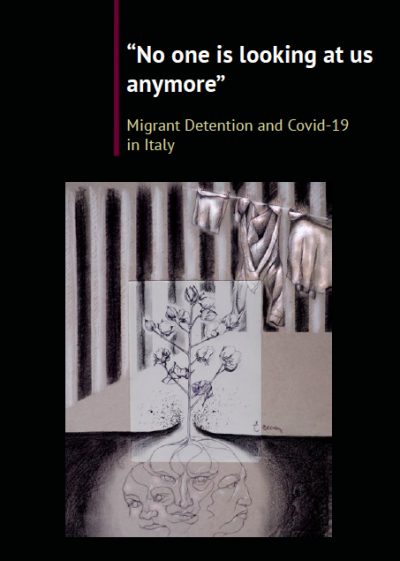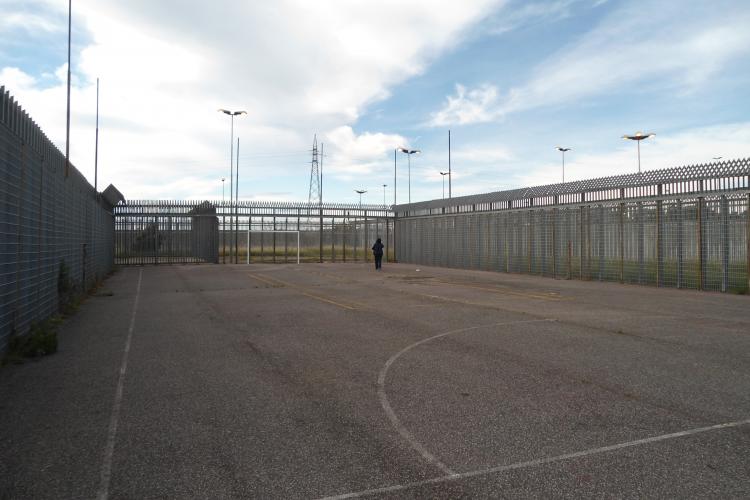‘No one is looking at us anymore’: Migrant Detention and Covid-19 in Italy
Posted:
Time to read:
Post by Francesca Esposito, Emilio Caja, and Giacomo Mattiello. Francesca is a Newton International Fellow at the Centre for Criminology at the University of Oxford; Emilio recently graduated from the Department of Politics and International Relations at the University of Oxford; Giacomo Mattiello recently graduated in Political Science at the University of Milan and is now a student of Anthropology at the University of Turin.


In this worrisome context, along with many activists and scholars around the world, we felt compelled to do something. We knew that custodial sites like detention centres, and the people confined inside them, could easily be forgotten during the pandemic and become more invisible than what they usually are. It is this sense of urgency to ‘do something’ from our ‘privileged’ sites of lockdown, and the recognition that monitoring what was happening behind the doors of these institutions was particularly crucial during this time, that has guided the drafting of this report, which focuses on the period of the national lockdown in Italy. (9th March.-18th May)
This report is also part of a larger project, ‘Immigration Detention in Italy and Greece: Safeguarding Human Rights at Europe’s Southern Frontier’ led by Mary Bosworth in collaboration with Andriani Fili and Francesca Esposito and funded by Open Society Foundation (OSF). This project was designed to ensure that what happens in sites of border control is not hidden from public scrutiny, that migrant voices are heard, and that activists and human rights defenders are given information and support to disseminate their evidence to a wider audience which is not limited to their national contexts but reaches out globally. To achieve this aim, an interactive map—the Landscapes of Border Control—was launched in the beginning of 2020. This map depicts Italy and Greece as they are experienced and shaped by migrants’ presence and their struggles.
What our analysis overall revealed is that although the number of people in Italian detention centres has slightly decreased in the period from March to May 2020, this reduction has been governed by selective logics of social control. Logics which have ultimately established a sort of ‘hierarchy of detention deservingness.’
In line with previous findings by Francesca Esposito, which demonstrate how gendered and racialised notions of ‘vulnerability’ and ‘dangerousness’ shape the continuous (re)drawing of the line between ‘deserving’ and ‘undeserving’ subjects in detention, women and asylum seekers were the first to be released (this trend was common to other countries too; see here at 11 May, here, and here). In other words, these were the first groups deemed ‘worthy of compassion.’ Unsurprisingly, on the other hand, homeless people – many of whom also face mental health challenges – and foreign nationals with criminal records are the ones who continued to enter and populate detention facilities during this period. This evidence highlights the role of constructions of ‘social marginality’ and ‘dangerousness’ as main forces behind the selective enforcement of detention during the period of our analysis.
It is also interesting to note how these constructions, which predated the pandemic as demonstrated by the work of Giuseppe Campesi and Giulia Fabini, were further modified by the hygienic-sanitary logic of bordering at stake in this period. As a result, it is the numerous migrant people without a ‘home to stay in’, and left in greater vulnerability due to the closure of the already limited health and social services available to them, that have become a prime target of police control and the racialised politics of containment (see, for instance, the case of Turin’s detention centre). Notably, most of these cases were assessed by Justices of the Peace who, even in the context of this global health emergency, have confirmed their tendency to validate and extend detention measures ordered by the Public security authority - in contrast to the guidelines usually adopted by the specialised sections of the Courts (on this topic see also here).
Another interesting evidence emerging from our report concerns the regime of everyday life inside these institutions and the strategies of power used to govern detained migrants. What the accounts collected by our research team reveal is that, on the whole, detainees were left abandoned inside the centres while also being exposed to very precarious living conditions. Sometimes they were not even provided with appropriate information about the virus and equipment to protect their health. These findings are not new and many migrants, activists, and scholars have already mentioned during the years the sense of abandonment which reigns in these remote sites, often kept far away from the public eye. It is this same sense of abandonment which is often mentioned to distinguish detention centres from other custodial institutions, such as prisons. Yet, we argue that the pandemic has rendered this evidence acutely visible, thus shedding light on the use of abandonment and neglect as specific modes of governing people confined in these sites (see similar analyses as applied to other national detention contexts). Making use of the words of a detainee interviewed by Radio Radicale at the beginning of the Covid-19 outbreak:
We are like horses inside the stables, closed, and no one is listening to us, no one of those, both the internal bodies here and those outside, i.e. the Ministry, the Quaestor. Because no one is looking at us anymore, because this is now a national, international emergency.
This situation has been aggravated by the increased veil of opacity hovering around these institutions due to the suspension of visits from relatives and friends as well as from external associations/groups.

To conclude, the pandemic has resulted in countries around the world closing their borders, which has largely impeded deportation enforcement; however, Italian police and migration authorities have continued to detain people. In doing so, detention has fundamentally confirmed its function as a containment measure used to manage ‘undesirable’ and ‘problematic’ populations and hold them out of the public space, especially in times of national and global health concerns.
Other countries, however, have shown a different approach. For instance, already in early April the Spanish Ministry of Interior declared the government’s intention to release detained migrants and temporarily close all detention centres (there called Centros de Internamiento de Extranjeros-CIEs). This plan was ultimately completed on the 6th of May, when Spanish authorities announced that all detention centres were completely empty (the situation was different in the two Centers for Temporary Stay of Immigrants (CETIs) located in the enclaves of Ceuta and Melilla where the conditions worsened instead). Notwithstanding all the limitations associated with this process, and mainly the fact that the closure of the CIEs was a temporary measure linked to the Covid-19 pandemic and now people have started to be detained again, we do believe this is a significant event. It shows that we can live without these carceral institutions. It also demonstrates that it is not too difficult to end migrant detention and let people move and live in our communities freely: it is a concrete, not a utopian scenario. It is a collective scenario, we argue, that we need to strongly advocate for in the near future.
You can read the report here.
Any comments about this post? Get in touch with us! Send us an email, or post a comment here or on Facebook. You can also tweet us.
__________
How to cite this blog post (Harvard style)
Esposito, F., Caja, E. and Mattiello, G. (2020). ‘No one is looking at us anymore’: Migrant Detention and Covid-19 in Italy. Available at: https://www.law.ox.ac.uk/research-subject-groups/centre-criminology/centreborder-criminologies/blog/2020/11/no-one-looking-us [date]
Share:








